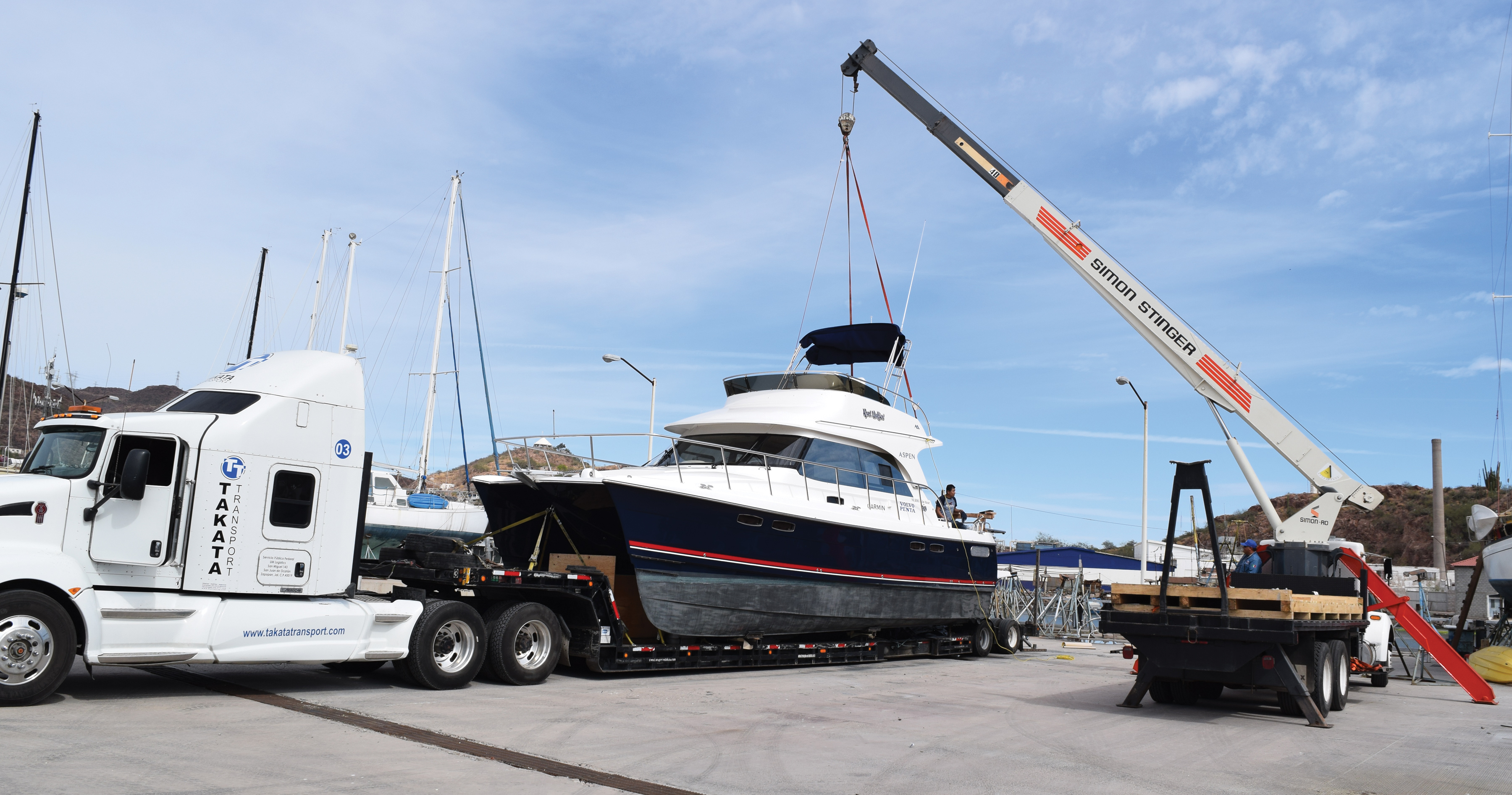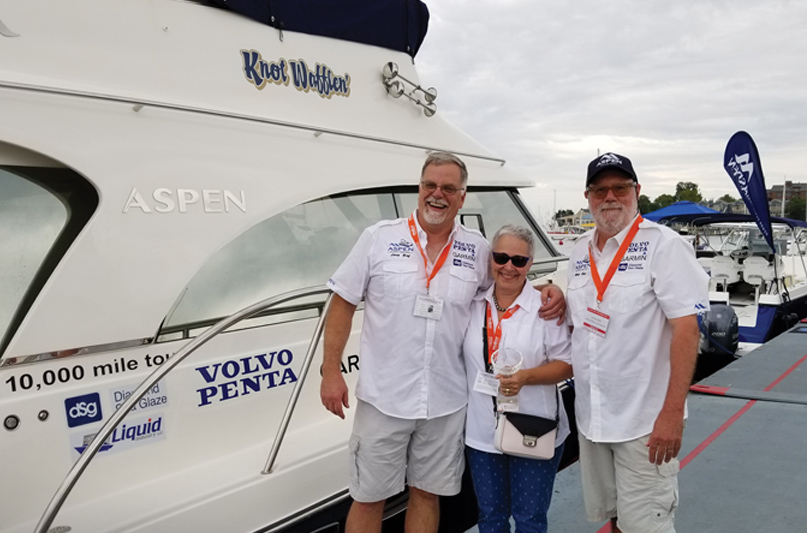 Eight months ago, we covered the story of the 40’ Aspen C120 power catamaran Knot Wafflen’s journey through the azure waters of Mexico with Larry Graf (owner of Aspen Power Catamarans) at the helm, his son Nick Graf acting as first mate, and our managing editor Norris Comer, the man on the scene for this stage of the Alaska to Annapolis voyage. Since the sun- and tequila-soaked days living la vida loca in La Paz, Knot Wafflen’ crossed Mexico’s countryside overland, navigated the Gulf of Mexico, visited the Bahamas, and continued up the East Coast to end her voyage in Annapolis, Maryland, with the help of Captain Blake Eder and owners David and Sue Ellen Jenkins along for most of the ride. Itching to hear how the last few legs went, we caught up with Larry and David to get the latest on their 10,500-mile adventure.
Eight months ago, we covered the story of the 40’ Aspen C120 power catamaran Knot Wafflen’s journey through the azure waters of Mexico with Larry Graf (owner of Aspen Power Catamarans) at the helm, his son Nick Graf acting as first mate, and our managing editor Norris Comer, the man on the scene for this stage of the Alaska to Annapolis voyage. Since the sun- and tequila-soaked days living la vida loca in La Paz, Knot Wafflen’ crossed Mexico’s countryside overland, navigated the Gulf of Mexico, visited the Bahamas, and continued up the East Coast to end her voyage in Annapolis, Maryland, with the help of Captain Blake Eder and owners David and Sue Ellen Jenkins along for most of the ride. Itching to hear how the last few legs went, we caught up with Larry and David to get the latest on their 10,500-mile adventure.
According to Larry, crossing Mexico wasn’t easy. The 40’ Aspen Power Catamaran C120 was hauled out and disassembled in Guaymas to make the 1,600-mile overland trip. Six bolts were removed and 20’ of bonding adhesive cut to set free the flybridge, which also affected the engine controls, navigation lights, hydraulic steering, chart plotters, NMEA 2000 bus, and the stereo–all this had to be disconnected, capped, and secured.
A 14-foot wide semi-truck and 75-foot oversized trailer transferred Knot Wafflen’ across Mexico, and bridge construction led to a detour adding about 600 miles to the trip. After a U.S. Customs setback involving wood regulations and Texas’ strict thunderstorm laws, Knot Wafflen’ made it to Galveston with no buffer days to spare. In less than two days of tune-ups, detailing, and a third coat of bottom paint, she launched into the Gulf.

Larry and the crew took off on a grey Sunday morning, dodging shallow waters and hurricane-shifted markers on their way to New Orleans. “About 20 miles downstream, our Volvo, which had been purring like the proverbial kitten, dropped back to 2,600 rpm from 2,800,” explains Larry.
The crew was just about to leave Port Arthur for a 220-mile, open-gulf crossing when the engine acted up. This setback, along with changing weather conditions, required a backup plan: the Intercoastal Waterway. Inspections revealed nothing out of the ordinary; no fuel leaks, no excess water, no loose hose clamps. They then discovered a simple clogged filter, which was repaired after a stop at the West Marine in Lake Charles, Louisiana.
The Intercoastal Waterway stretches for 450 miles, is about 200’ wide, and overloaded with thousands of push barges about 600 feet long by 70 feet wide. “When two barges pass each other, well you can imagine how much space is left for us!” says Larry. He also didn’t expect the extensive wilderness they encountered along the way.
“An amazingly vacant kind of an area,” he reflects. “You could go 15-20 miles on the way to Alaska and have many places to stop for fuel, but here, you could go 6 or 7 hours at 17 knots and not see a thing … Most go to Alaska to see wilderness but where you really need to go is Louisiana.”
Closer to New Orleans, marine construction facilities came into view. Knot Wafflen’ passed wrecking yards, a field filled with old oil rig working boats, a steel boat factory, and more before arriving at the Mississippi River locks. After passing through, a Polish tanker nearly ran them over after exiting the locks on the flooded, fast-moving Mississippi; it turns out VHF channels change after the locks. As if that wasn’t enough, they were surrounded by other ships and tugs, all of which were moving at speeds up to 30 knots. They dodged logs left and right in the night, and the 4’ river chop wasn’t making the feat easier. They eventually made it to New Orleans safely, where they handed Knot Wafflen’ off to the Jenkins for the rest of the trip.
 David, Sue Ellen, and family enjoyed their time in New Orleans before heading off to Apalachicola, Fort Meyers, and other Florida sights before the Bahamas. I had the chance to speak to David Jenkins as he was en route to the Annapolis Boat Show, and he noted how fortunate he felt to have visited Fort Meyers pre-algae bloom and Apalachicola before the devastating hurricane blasted its shores.
David, Sue Ellen, and family enjoyed their time in New Orleans before heading off to Apalachicola, Fort Meyers, and other Florida sights before the Bahamas. I had the chance to speak to David Jenkins as he was en route to the Annapolis Boat Show, and he noted how fortunate he felt to have visited Fort Meyers pre-algae bloom and Apalachicola before the devastating hurricane blasted its shores.
Not long after their Marsh Harbour, Bahamas, arrival, David received a call from their insurance agency about their lack of coverage outside of the U.S. So, without hesitation, they flipped a 180 and made headway for the mainland, taking just seven days to cruise up to Annapolis. Once at port, David picked up Sue Ellen from the Annapolis dock to cruise under the Spa Creek Bridge together.
High-fives and popped Champagne echoed through the marina as they celebrated the conclusion of what ended up being their 10,500-mile voyage.
Knot Wafflen’ required minimal repairs with the largest being a shaft seal leak, which they had been cruising with since Florida. “Well, now that this epic adventure is over, what’s next on the agenda?” I asked David. What does one do after completing a half-circumnavigation of North America?
“Well, we’ve just about sold the boat,” explains David, which Larry confirmed was sold to another couple after less than 24 hours on the market, “and we’re going to take a break from boating for a while.” But after logging 1,001 engine hours and 10,500 miles aboard Knot Wafflen’, he feels a sense of accomplishment. He tells me, “I started this trip pretty inexperienced, now I no longer need Blake. He’s my brother-in-law and he’s a nice guy, but I have no interest in boating with Blake anymore.” He follows with a light chuckle, “You can publish that, Blake will understand.”
During their time off, David and Sue Ellen plan to celebrate their 40th anniversary in January with a trip to Australia and New Zealand and spend this next year with their newly born granddaughter on the East Coast. But don’t worry! If you’ve followed along on this story, you’ll be happy to know that David and Sue Ellen have another Aspen on the way–a Knot Wafflen’ duplicate–and come next October, it’ll be delivered and ready for cruising.
They hope to come back to the Pacific Northwest and cruise the San Juan and Gulf Islands and the greater parts of British Columbia’s coast.